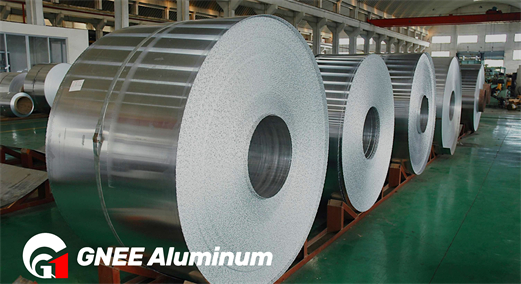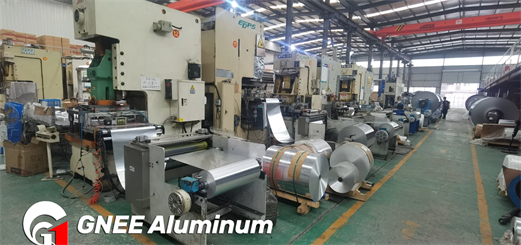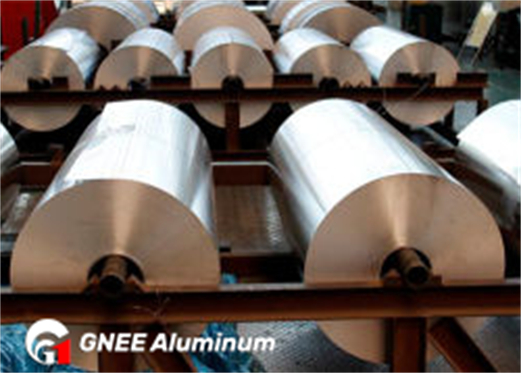Double-zero foil refers to a foil whose thickness is measured in millimeters and has two zeros after the decimal point (i.e. thickness <0.01mm, 0.009—0.0045mm); similarly, single-zero foil refers to a foil whose thickness is measured in millimeters and has a decimal point There is a zero foil at the end (0.01mm≤thickness<0.1mm, 0.01—0.099); thick foil refers to aluminum foil with a thickness between 0.1mm—0.2mm.
Double zero foil is mainly used in food packaging, cigarette packaging, electronic foil, capacitors, etc.; single zero foil is used in some food packaging, pharmaceutical packaging, electronic circuit signal shielding, air conditioning foil, etc.; thick foil is mainly used in air conditioning foil, container foil, Architectural decoration and industrial use.
The initial incoming material process of aluminum foil: (1) Ingot casting—hot rolling; (2) Double-roller type—casting and rolling.

Ingot hot rolling
First, the aluminum melt is cast into a flat ingot, and then after homogenization, hot rolling, cold rolling, intermediate annealing and other processes, it is continued to be cold rolled into a plate with a thickness of about 0.4~1.0 mm as a foil blank (casting → hot rolling) Billet→cold rolling→foil rolling).
In the ingot hot rolling method, the hot-rolled billet is first milled to remove defects such as the oxide layer and impurities on the surface of the ingot, and then the microstructure of the ingot is made more uniform through homogenization, and then hot rolling, cold rolling and intermediate After multiple processes such as annealing and recrystallization, the internal structural uniformity and grain size of the billet have been significantly improved. Therefore, hot-rolled billets are usually of better quality and are suitable for high-quality double-zero aluminum foil and deep processing. Aluminum foil products. However, hot-rolled blanks have problems such as high ear yield, easy cracking, and uneven deformation areas during the deep drawing process, which restricts the improvement of the yield of high-quality aluminum foil.

Double roller casting and rolling
Compared with the ingot hot-rolling method, the process flow of producing aluminum foil blanks by the cast-rolling method is relatively simple; there is no need to go through complex process steps such as ingot melting, milling, homogenization and hot rolling, but the aluminum melt is poured directly. Enter two rotating casting rollers (crystallizer), and complete the solidification and hot rolling processes simultaneously in the casting and rolling area within 2 to 3 seconds to obtain a plate with a thickness of 4 to 7 mm. Similar to hot-rolled aluminum foil billets, cast-rolled plates also need to go through a series of cold rolling and intermediate annealing processes, and are finally rolled into 0.3~0.7mm thick plates as aluminum foil billets.
The double-roller casting and rolling method has simple equipment, low total investment, and short production cycle. It eliminates many tedious processes such as milling, homogenization, and hot rolling in the production of hot-rolled plates. Therefore, the casting-rolling method is more suitable for producing aluminum foil blanks. The cost is greatly reduced; however, due to the different cooling methods and hot processing conditions during the production of plates by the double-roll casting and rolling method, the internal structure of the cast-rolled plates mainly has shortcomings such as segregation, uneven structure, and coarse grain structure after annealing, and its quality control It is more difficult, so it is relatively rarely used in high-quality aluminum foil products.
At present, the process of casting and rolling applied to aluminum foil blanks is gradually maturing. More and more companies are beginning to use the casting and rolling process to produce aluminum foil. Casting and rolling have become the mainstream front-end process for aluminum foil.

Generally speaking, thick foil only needs to go through rough rolling, single zero foil needs to go through rough rolling and intermediate rolling, double zero foil and other aluminum foils with higher precision requirements need to go through rough rolling, intermediate rolling and finish rolling, and finally slit and annealed. Packaging and storage.